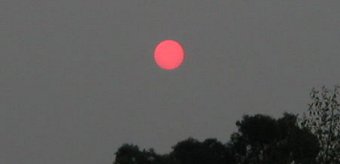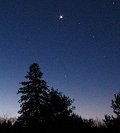| What's Up in Space -- 23 Jan 2003
Subscribe to Space Weather News! AURORA WARNING: Solar wind gusts are buffeting Earth's magnetic field today, so sky watchers should be alert for auroras. No matter where you live, the best time to look will be during the hours around local midnight on Jan. 23rd and Jan. 24th. 
Above: Australian Chris Wyatt took this picture of the Sun on Jan. 23rd "through the smoke of brushfires burning some 250km east of Bendigo. The sun was so dimmed," says Wyatt, "I could use 10x50 binoculars and see six groups of sunspots on the face of the sun." SUNSPOT WATCH: None of the spots on the Sun today look impressive, yet solar activity is rising. X-ray sensors on Earth-orbiting satellites have recorded at least three M-class solar flares since Tuesday. One of the explosions on Jan. 21st hurled a coronal mass ejection into space--but not toward Earth.  HOUR OF THE PLANETS: Dashing out the door to work or school? Pause for a moment and look up. Two dazzling planets are in the morning sky: Venus and Jupiter. Even after all the other stars and planets have begun to fade against the brightening sky, these two are absolutely eye-catching. [full story] HOUR OF THE PLANETS: Dashing out the door to work or school? Pause for a moment and look up. Two dazzling planets are in the morning sky: Venus and Jupiter. Even after all the other stars and planets have begun to fade against the brightening sky, these two are absolutely eye-catching. [full story]
Right: "I braved -3o F in northeastern Wisconsin to capture this photo of Venus reigning in the clear morning sky," says Peg Staudenmaier. STARSHINE RETURNS: Prof. Gil Moore, the director of Project Starshine, reports: "The Starshine 3 satellite re-entered Earth's atmosphere shortly after 0500 UT (midnight EST) on January 21, 2003. It was on a ground track that passed over central California, Nevada, Idaho and western Canada, swept across Hudson's Bay in Canada, over the southern tip of Greenland, down along the eastern coast of Scotland and England, continuing in a southeasterly direction along the length of Italy, across the Mediterranean and into North Africa. That covers a lot of populated territory, and I'm really hoping someone saw it." If you saw the fireball or (better yet) took its picture, please let us know! WEB LINKS: NOAA FORECAST | GLOSSARY | SPACE WEATHER TUTORIAL | BECOME A SUBSCRIBER | SpaceWeather PHONE | 
